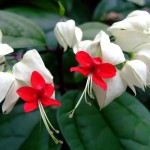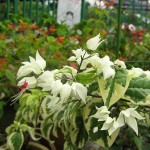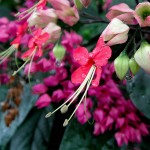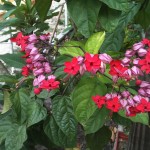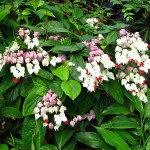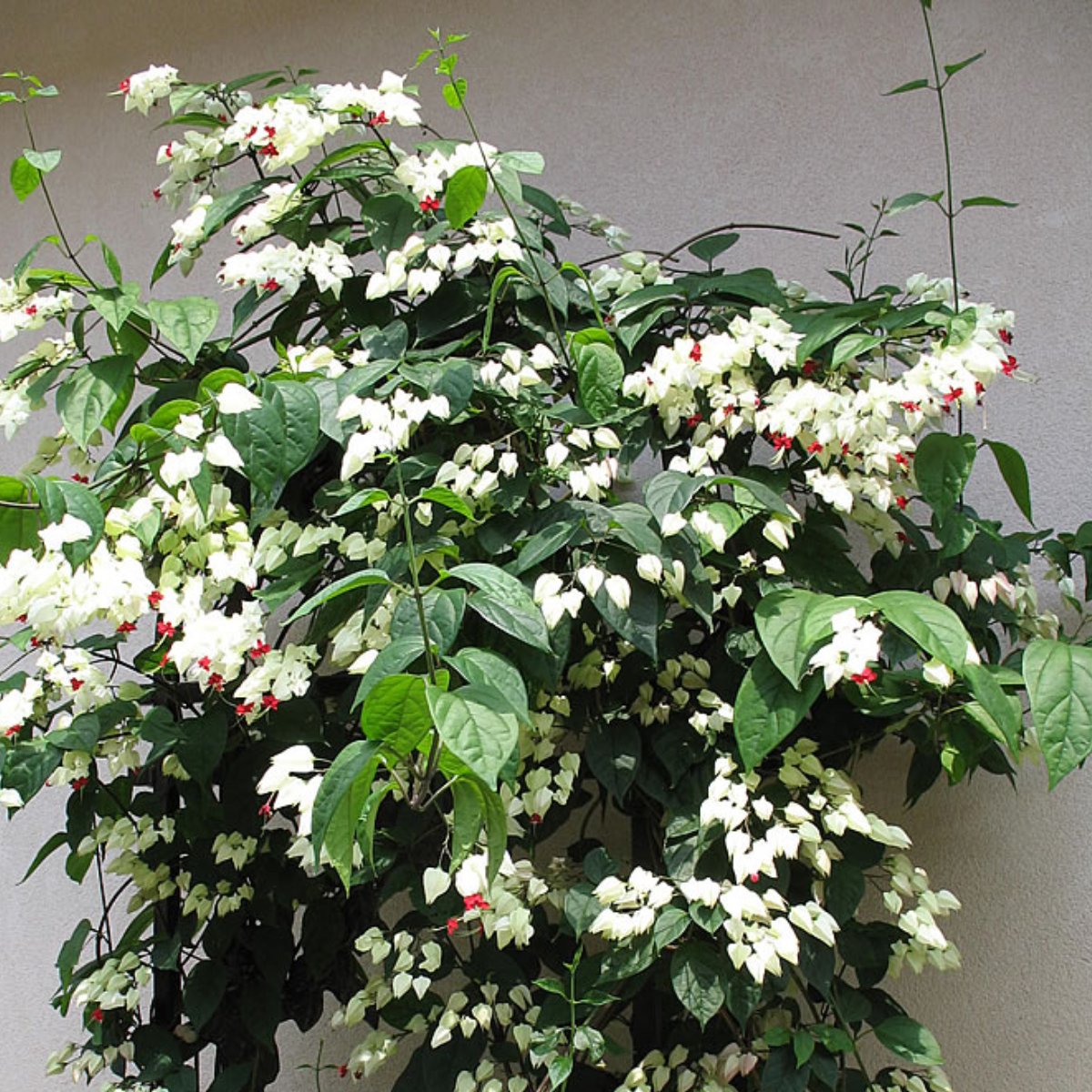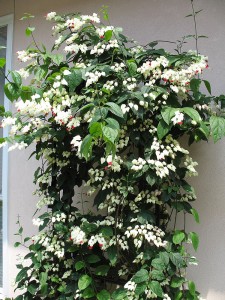Family: Lamiaceae
Distribution and habitat: Clerodendrum thomsoniae is an evergreen liana growing to 4m (13 feet) tall, native to tropical west Africa from Cameroon west to Senegal. In some regions it has escaped from cultivation and become naturalised.
Description: Clerodendrum thomsoniae is a vigorous twining shrub with striking flowers. The leaves are rather coarse, heart-shaped, up to 13cm (5 inch) long and 5cm (2 inch) wide and coloured deep green with slightly paler vein markings. Flowers, which are produced on wiry flower stalks st stems ends during the spring and summer and early autumn, grow in clusters of 10 to 30. Each flower consists of 2cm (0.8 inch) long, white (or else greenish white), bell-shaped calyx with a scarlet, star-shaped bloom peeping through a split in its tip. The contrast of scarlet and white is highly effective.
Houseplant care: Clerodendrum thomsoniae can grow inconveniently high - 3m (10 feet) or more - but may be kept below 1.5m (5 feet) by having its stem tops pinched out regularly during the growing season; the stems themselves can also be trained around three or four thin stakes in the potting mixture. This species can make an attractive trailing plant when kept under control in a large hanging basket. Although not difficult to grow, it will not flower unless given adequate humid warmth during the active growth period.
At the end of the rest period, as new growth becomes apparent, cut back at least half the previsions year's growth in order to keep these plants within bounds. Because flower buds are produced on current seasons growth, pruning at this time will encourage the production of vigorous flowering shoots.
Light: Grow Clerodendrum thomsoniae in bright filtered light. They will not flower unless there is a constant source of adequate light.
After pruning, move the plant to a warm, brightly lit location or outdoors if temperatures have warmed sufficiently.
Temperature: Clerodendrum thomsoniae plants will do well at normal room temperatures during the active growth period, but they should be given a winter rest in a cool position - ideally at about 10-13C (50-55F). To ensure satisfactory flowering, provide extra humidity during the active growth period by mist-spraying the plants every day and by standing the pots on trays or saucer of moist pebbles.
Watering: During the active growth period water Clerodendrum thomsoniae plentifully, as much as necessary to keep the potting mixture thoroughly moist, but never allow the pot to stand in water. During the rest period water only enough to keep the mixture from drying out.
Feeding: Give actively growing plants applications of liquid fertiliser every two weeks. Withhold fertiliser during the winter rest period.
Potting and repotting: Use a soil based potting mixture. Young plants should be moved into pots one size larger when their roots have filled the pot, but mature plants will flower best if kept in pots that seems a little too small. Quite large specimens can be grown effectively in 15-20cm (6-8 inch) pots. Even when pot size is not changed, however, these Clerodendrum thomsoniae should be repotted at the end of every rest period. Carefully remove most of the old potting mixture and replace it with fresh mixture to which has been added a small amount of bone meal.
Gardening: Clerodendrum thomsoniae plants grow outdoors in warm, sheltered and frost-free areas. If these plants are damaged by light frost, burnt tips and leaves should be left on the plant until spring and then cut away to make way for vigorous new growth.
Clerodendrum thomsoniae plant can be kept pruned into a shrub or given support and allowed to scramble like a vine. This vine-like shrub does not spread much, thus is a good choice for a restricted support like a doorway arch or container trellis and not such a good candidate to cover a fence or arbor.
Position: Clerodendrum thomsoniae will tolerate full sun with adequate moisture but they will prefer partial shade. Best flowering results occur with morning sun and afternoon shade.
Keep these plants protected from strong winds, hot sun and frost.
Soil: Clerodendrum thomsoniae grown in garden like a well-drained soil, rich in organic material. If planted in a garden bed, make sure the soil is well-drained. Dig hole twice the width of the container. Remover plant from container and place into the hole so the soil level is the same as the surrounding ground. Fill hole firmly and water in well even if the soil is moist.
Irrigation: Clerodendrum thomsoniae likes high humidity and a moist, but not soggy, soil. Give it a generous watering regime during growth period. Regular watering will encourages new growth. As the plant grows its thirst grows with it. A Clerodendrum thomsoniae vine that occupies 9m (3 feet) trellis can drink 10l (3 gallons) of water weekly.
Fertiliser: Clerodendrum thomsoniae is a heavy feeder. To produce profuse flowers through the growing season, apply either a slow release-type fertiliser with micronutrients every two months or a liquid water soluble fertiliser with micronutrients monthly. Bloom should continue throughout the season if adequate amounts of calcium are available to the plant. If the fertilizer chosen not have calcium, a separate calcium supplement may be applied. Crushed eggshells stirred into the soil are an excellent organic calcium supplement for plants.
Propagation: Propagate in spring from cuttings 10-15cm (4-6 inch) long. Dip each cutting in a hormone rooting powder and plant it in an 8cm (3 inch) pot containing a moistened equal-parts mixture of peat moss and coarse sand or a substance such as perlite. Enclose the pot in a plastic bag or heated propagating case and keep it at a temperature of at least 21C (70F) in a position where it gets medium light. Rooting will take four to six weeks; when new growth indicates that rooting has occurred, uncover the pot and begin watering the young plant sparingly - just enough to make the potting mixture barely moist - and start application of a liquid fertiliser every two weeks.
About four months after the beginning of propagation process, move the plant into a soil based potting mixture. Thereafter, treat it as a mature Clerodendrum thomsoniae plant.
Problems:
Watch for mealybugs and spider mites.
Treatment: Use appropriate insecticides. Alternatively, remove mealybugs with an alcohol saturated cotton swab or wash plants with soapy water.
Glasshouse whitefly can be a problem, especially indoors.
Treatment: Successive sprays of insecticidal soaps or white oil will eradicate whiteflies infestations.
Clerodendrum thomsoniae blooms heavily in spring and summer. If it does not bloom much, move it to where it will get indirect light from a south- or west-facing window.
Recommended varieties:
Clerodendrum thomsoniae 'Delectum' has rose-magenta flowers in very large clusters.
Clerodendrum thomsoniae 'Variegatum' has flowers like those of the main species, but its leaves are pale green at the margins and have light and dark green marbling in the central portion.
Uses and display: Clerodendrum thomsoniae makes an excellent hanging container plant or can be trained on a trellis. It is a non-invasive climber for a fence, pergola or trellis indoor plant for brightly lit conservatory or sunroom bold, eye-catching flowers provide colour for much of the year. This evergreen climbing plant will clothe and decorate the wall, trellis or other support that it grows against. In a sunroom or conservatory it makes a splendid backdrop. For a formal look, grow this plant in a large white wooden conservatory box.
SUMMARY:
CHARACTERISTICS:
Foliage green
Features flowers
Shape climbing and trailing or bushy
Height: 4m (13 feet)
PROPER CARE:
Watering in rest period sparingly
Watering in active growth period plentifully
Light bight filtered
Temperature in rest period min 10C max 13C (50-55F)
Temperature in active growth period min 16C max 24C (61-75F)
Humidity high
Hardiness zone: 10a-11
